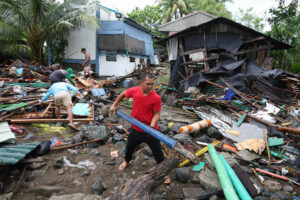By Adrian H. Halili and Chloe Mari A. Hufana, Reporters
TYPHOON Fung-wong, locally known as Uwan, killed at least two and displaced more than a million people after sweeping across Luzon and the Visayas, the National Disaster Risk Reduction and Management Council (NDRRMC) said on Monday.
The 21st storm to hit the Philippines this year brought flooding, storm surges, strong winds and landslides as it made landfall in Dinalungan, Aurora province on Sunday evening. The NDRRMC said two deaths were recorded in Bicol and Eastern Visayas, with two injuries reported in Western Visayas and Bicol.
About 1.198 million people were affected, including 523,383 who sought refuge in evacuation centers. Deputy Administrator Bernardo Rafaelito Alejandro said local agencies were still validating the incidents.
“The storm right now is out of landmass, there are only scattered rains in Central and Northern Luzon,” he told a livestreamed briefing.
The state weather bureau expects Fung-wong to leave the Philippine area of responsibility by Monday night or early Tuesday, though it may re-enter by Wednesday as it moves toward Taiwan.
The storm weakened from super typhoon to typhoon after crossing Luzon. As of Monday, it was 135 kilometers west-northwest of Bacnotan, La Union, moving at 20 kilometers per hour (kph) with maximum sustained winds of 130 kph and gusts up to 160 kph.
Mr. Alejandro added that at least 6,200 passengers, 2,900 rolling cargos, 80 vessels and 24 motorboats remained stranded. The NDRRMC also issued 72 emergency alerts on tropical cyclone, heavy rainfall and storm surge warnings.
PAGASA forecast storm surges over three meters in coastal areas of Ilocos Region, Cagayan Valley, Central Luzon, Metro Manila, Calabarzon, Mimaropa, Aklan and Antique. Tropical Cyclone Wind Signals ranged from No. 1 to No. 3 across Luzon, including Metro Manila under Signal No. 1.
The agency warned mariners against sea travel on northern and central Luzon seaboards, advising vessels to remain in port or seek safe harbor until conditions improve.
Fung-wong follows Typhoon Kalmaegi (Tino), which earlier this month caused more than 200 deaths from flash floods in the Visayas and Mindanao.
President Ferdinand R. Marcos, Jr. ordered the continued deployment of relief and medical teams to communities hit by Fung-wong.
Palace Press Officer Clarissa A. Castro said the President had ordered the Department of Social Welfare and Development (DSWD) to maintain uninterrupted aid delivery and closely monitor evacuation centers after a Palace meeting on Monday.
The DSWD said the Bicol Region had the most evacuees, with more than 100,000 families affected. About 44,000 families were displaced in Camarines Sur and 20,000 in Quezon Province. As floodwaters subside, authorities expect evacuees to begin returning home.
Mr. Marcos also directed the Department of Health to send medical teams to evacuation sites to prevent disease outbreaks, and the Department of Public Works and Highways to repair damaged roads to ensure aid access.
Government data showed 71 road sections remained impassable, mainly in Central Luzon and the Cordillera region, including parts of Mountain Province, Benguet, Apayao and Aurora.
The Office of Civil Defense said Pangasinan was among the hardest-hit provinces, though floodwaters there have receded. Four deaths have been reported, with two still under verification. No missing persons have been recorded, while rescue work continues.
Mr. Marcos instructed all government agencies to stay on alert until Tuesday and continue rehabilitation in areas previously affected by Typhoon Kalmaegi and those damaged by Uwan.
About 4.78 million electricity consumers across six regions in Luzon and the Visayas remained without power after Uwan brought strong winds and heavy rains, the National Electrification Administration (NEA) said.
In its 8 a.m. update, the agency said 26 electric cooperatives across 18 provinces were still experiencing blackouts, including in Ilocos, Cagayan Valley, Central Luzon, the Cordillera Administrative Region, Bicol and Eastern Visayas.
“Everything will be inspected, and the electric cooperatives will conduct line assessments to ensure safety, particularly for meters under floodwater,” NEA Administrator Antonio Mariano C. Almeda said in a statement.
Separately, Manila Electric Co. (Meralco) said the number of customers affected by power interruptions had fallen to 197,000 from over 400,000 at midnight. Of those still without electricity, about 10,000 were in flooded areas.
Most remaining power failures were in Cavite, Bulacan, Quezon and Metro Manila, with additional affected customers in Rizal, Laguna and Batangas.
“We continue to actively monitor the weather situation in light of persisting strong winds and rains brought about by the super typhoon,” Joe R. Zaldarriaga, Meralco vice-president and head of corporate communications said in a statement.
The National Grid Corp. of the Philippines said 26 transmission lines in Luzon and 11 in the Visayas were unavailable.
The Philippines remains under a state of calamity after the twin storms left extensive damage across several regions. The country, which faces about 20 typhoons each year, remains vulnerable to severe flooding and landslides brought by tropical cyclones. — with Sheldeen Joy Talavera
